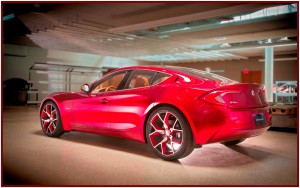
In essence, Fisker Automotive has a range problem similar to EVS. There are doubts about whether it can create 2,000 jobs by building 100,000 plug-in hybrids per year at a 3.2 million square-foot factory in Delaware (or will it be China?) before it runs out of cash.
Fisker Automotive announced today the resignation of its Executive Chairman, Henrik Fisker who in turn said there were disagreements with the oft-changing management team, which had three different CEOs during 2012. Fisker, a car designer by trade, had been executive chairman of the hybrid electric car company that he helped found in 2007.
The beleaguered company has sold about 2,000 of the Finnish-built $102,000 Karma plug-in hybrids, but has never earned a profit. It was severely hurt by the bankruptcy of A123, an investor and supplier of lithium ion batteries for the Karma. The Karma ceased production as the remains of A123, U.S. taxpayer subsidized with $249 million in Department of Energy loans, were sold to the Chinese. Fisker now faces a serious challenge by the Cadillac ELR, a sharp looking $65,000 hybrid coupe that will go on sale this year with the backing and capital of General Motors behind it.
There have been persistent rumors that the Chinese were interested in buying Fisker and moving it to China, potentially problematic since the company also accepted DOE loans. The DOE advanced technology loan programs have been subject to criticism, particularly among Republicans in Congress, since the bankruptcy of solar-panel maker Solyndra in 2011, which was also the subject of taxpayer subsidies. At least two other ‘green’ company start-ups have failed after receiving taxpayer money through the DOE.
Roger Ormisher, a spokesperson for Fisker, told AutoInformed that the “company has a strong and experienced management team and its strategy has not changed.” He added that “Mr. Fisker’s departure is not expected to impact the Company’s pursuit of strategic partnerships and financing to support Fisker Automotive’s continued progress as a pioneer of low-emission hybrid electric powertrain technology.”
Nevertheless, the future of Fisker is not clear. In 2010, the U.S. Energy Department awarded Fisker $529 million in loans as part of an effort to help development of so-called advanced-technology vehicles. Part of the loan was for redeveloping a closed General Motors plant in Wilmington, Delaware – home state of vice president Joe Biden – to build a small electric car, code named Nina – that has yet to appear. Promised were 2,000 autoworker jobs building 100,000 units per year at a 3.2 million square-foot factory. Fisker said that about one-third of the total loan amount – $190 million – was drawn, mostly for Karma design and development before the DOE put a hold on the balance.
Tony Posawatz, who joined Fisker last summer from his previous job as head of the Volt electric vehicle program at General Motors, is currently trying to raise the funds needed to keep Fisker solvent and open the Delaware plant to build the Atlantic. Last spring, at the New York Auto Show, a four-door Atlantic prototype was shown. The plug-in series hybrid that will be priced, it’s said, starting around $50,000, if the loss-making start-up company ever gets the funding needed to refurbish and tool a former General Motors plant to build it.
See:
- Fisker Appoints New CEO – Tony Posawatz from GM’s Volt Program
- Cadillac ELR Hybrid Faces Same Tough Market as Chevrolet Volt
- Fisker and Leonardo DiCaprio to Work on ‘Sustainability’
- Fisker Automotive Makes Tom LaSorda CEO
- A123 Recalls Lithium Ion Batteries Shipped to Fisker, Others
- Fisker Shows Atlantic EV – Will It Ever Be Built?
- Fisker Expands Karma Battery Recall for Potential Fires
- Penske Automotive Adds a Fisker Dealership in Arizona
- Taxpayer Funded A123 Systems Claims Breakthrough Battery

